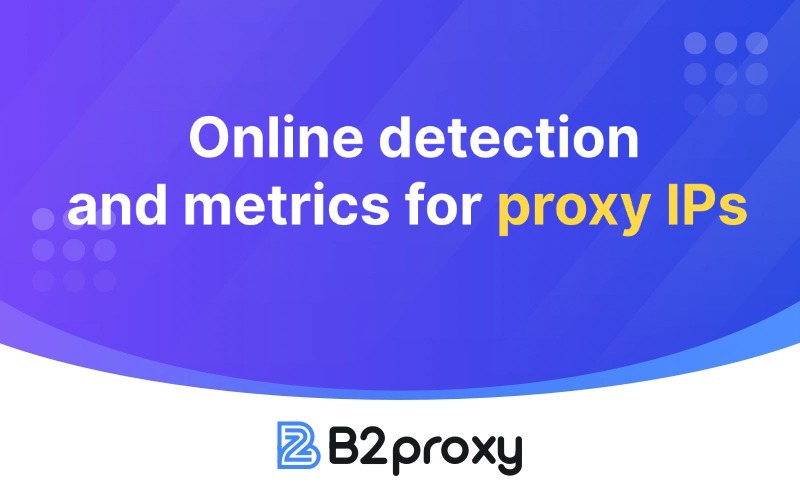
POST Requests and Proxy IPs: Best Practices for Efficient Data Submission and Anonymous Transmission
POST Requests and Proxy IPs: Best Practices for Efficient Data Submission and Anonymous Transmission
 August 12.2025
August 12.2025

<p style="margin: 4px 0px; font-family: 等线; font-size: 16px; line-height: 2em;"><span style="font-size: 15px;letter-spacing: 0;vertical-align: baseline">In internet data exchange, </span><span style="font-size: 15px;font-weight: bold;letter-spacing: 0;vertical-align: baseline">POST requests</span><span style="font-size: 15px;letter-spacing: 0;vertical-align: baseline"> are one of the most commonly used methods for submitting data, widely applied in scenarios such as form submissions, user registrations, file uploads, payment requests, and API calls. However, frequent and large-scale POST requests often face challenges like IP bans, request failures, and slow speeds. This is where </span><span style="font-size: 15px;font-weight: bold;letter-spacing: 0;vertical-align: baseline">proxy IPs</span><span style="font-size: 15px;letter-spacing: 0;vertical-align: baseline"> become the key to solving these problems.</span></p><p style="margin: 4px 0px; font-family: 等线; font-size: 16px; line-height: 2em;"><span style="font-size: 15px;letter-spacing: 0;vertical-align: baseline">As an industry-leading proxy IP service provider, </span><a href="https://www.b2proxy.com/" target="_self"><span style="font-size: 15px;font-weight: bold;letter-spacing: 0;vertical-align: baseline">B2Proxy</span></a><span style="font-size: 15px;letter-spacing: 0;vertical-align: baseline"> is especially suitable for cross-border data transmission, ad verification, social media operations, and big data collection. Combining POST requests with B2Proxy proxy IPs can significantly improve transmission efficiency, increase success rates, and effectively protect user privacy.</span></p><h3 class="paragraph text-align-type-left tco-title-heading 3" style="line-height: 2em;"><span style="font-size: 19px;letter-spacing: 0;vertical-align: baseline">Core Principles of POST Requests</span></h3><p style="margin: 4px 0px; font-size: 16px; font-family: 等线; line-height: 2em;">1. <span style="font-size: 15px;font-weight: bold;letter-spacing: 0;vertical-align: baseline">Data Submission Method</span><span style="font-size: 15px;letter-spacing: 0;vertical-align: baseline"> – POST requests transmit data via the HTTP protocol by encapsulating it in the request body, making them suitable for sending sensitive information and large amounts of data.</span></p><p style="margin: 4px 0px; font-size: 16px; font-family: 等线; line-height: 2em;">2. <span style="font-size: 15px;font-weight: bold;letter-spacing: 0;vertical-align: baseline">High Security</span><span style="font-size: 15px;letter-spacing: 0;vertical-align: baseline"> – Compared with GET requests, POST data does not appear in the URL, making it more suitable for transmitting passwords, payment details, and other sensitive information.</span></p><p style="margin: 4px 0px; font-size: 16px; font-family: 等线; line-height: 2em;">3. <span style="font-size: 15px;font-weight: bold;letter-spacing: 0;vertical-align: baseline">Cross-Application Scenarios</span><span style="font-size: 15px;letter-spacing: 0;vertical-align: baseline"> – Almost all web interactions, mobile apps, and API calls rely on POST requests for writing or submitting data.</span></p><h3 class="paragraph text-align-type-left tco-title-heading 3" style="line-height: 2em;"><span style="font-size: 19px;letter-spacing: 0;vertical-align: baseline">The Role of Proxy IPs in POST Requests</span></h3><p style="margin: 4px 0px; font-size: 16px; font-family: 等线; line-height: 2em;">1. <span style="font-size: 15px;font-weight: bold;letter-spacing: 0;vertical-align: baseline">Bypassing IP Restrictions</span><span style="font-size: 15px;letter-spacing: 0;vertical-align: baseline"> – Proxy IPs can switch between different IP addresses to avoid bans caused by frequent requests from the same IP.</span></p><p style="margin: 4px 0px; font-size: 16px; font-family: 等线; line-height: 2em;">2. <span style="font-size: 15px;font-weight: bold;letter-spacing: 0;vertical-align: baseline">Improving Success Rates</span><span style="font-size: 15px;letter-spacing: 0;vertical-align: baseline"> – Stable and high-speed proxy IPs can reduce issues such as timeouts and connection interruptions.</span></p><p style="margin: 4px 0px; font-size: 16px; font-family: 等线; line-height: 2em;">3. <span style="font-size: 15px;font-weight: bold;letter-spacing: 0;vertical-align: baseline">Anonymity and Privacy Protection</span><span style="font-size: 15px;letter-spacing: 0;vertical-align: baseline"> – Proxy IPs hide the real IP address, preventing servers from tracking the source of requests.</span></p><p style="margin: 4px 0px; font-size: 16px; font-family: 等线; line-height: 2em;">4. <span style="font-size: 15px;font-weight: bold;letter-spacing: 0;vertical-align: baseline">Multi-Region Testing and Access</span><span style="font-size: 15px;letter-spacing: 0;vertical-align: baseline"> – By using proxy IPs from different countries, POST requests can simulate user behavior in various regions for ad testing, price monitoring, and more.</span></p><h3 class="paragraph text-align-type-left tco-title-heading 3" style="line-height: 2em;"><span style="font-size: 19px;letter-spacing: 0;vertical-align: baseline">Best Practices for POST Requests with Proxy IPs</span></h3><p style="margin: 4px 0px; font-size: 16px; font-family: 等线; line-height: 2em;">1. <span style="font-size: 15px;font-weight: bold;letter-spacing: 0;vertical-align: baseline">Choose High-Quality Proxy IPs</span><span style="font-size: 15px;letter-spacing: 0;vertical-align: baseline"> – Prefer residential proxies for better stability.</span></p><p style="margin: 4px 0px; font-size: 16px; font-family: 等线; line-height: 2em;">2. <span style="font-size: 15px;font-weight: bold;letter-spacing: 0;vertical-align: baseline">Control Request Frequency</span><span style="font-size: 15px;letter-spacing: 0;vertical-align: baseline"> – Avoid sending too many POST requests in a short period to prevent bans.</span></p><p style="margin: 4px 0px; font-size: 16px; font-family: 等线; line-height: 2em;">3. <span style="font-size: 15px;font-weight: bold;letter-spacing: 0;vertical-align: baseline">Use Automatic IP Rotation</span><span style="font-size: 15px;letter-spacing: 0;vertical-align: baseline"> – Rotate IPs through a proxy pool to keep requests evenly distributed.</span></p><p style="margin: 4px 0px; font-size: 16px; font-family: 等线; line-height: 2em;">4. <span style="font-size: 15px;font-weight: bold;letter-spacing: 0;vertical-align: baseline">Combine with HTTPS Encryption</span><span style="font-size: 15px;letter-spacing: 0;vertical-align: baseline"> – Protect POST data during transmission.</span></p><h3 class="paragraph text-align-type-left tco-title-heading 3" style="line-height: 2em;"><span style="font-size: 19px;letter-spacing: 0;vertical-align: baseline">FAQ</span></h3><p style="margin: 4px 0px; font-family: 等线; font-size: 16px; line-height: 2em;"><span style="font-size: 15px;font-weight: bold;letter-spacing: 0;vertical-align: baseline">Q1: What’s the difference between POST and GET requests?</span></p><p style="margin: 4px 0px; font-family: 等线; font-size: 16px; line-height: 2em;"><span style="font-size: 15px;letter-spacing: 0;vertical-align: baseline">A: POST requests place data in the request body, offering higher security and suitability for sensitive data and large files. GET requests append data to the URL, making them more suitable for simple data retrieval.</span></p><p style="margin: 4px 0px; font-family: 等线; font-size: 16px; line-height: 2em;"><span style="font-size: 15px;font-weight: bold;letter-spacing: 0;vertical-align: baseline">Q2: Why use a proxy IP for POST requests?</span></p><p style="margin: 4px 0px; font-family: 等线; font-size: 16px; line-height: 2em;"><span style="font-size: 15px;letter-spacing: 0;vertical-align: baseline">A: Proxy IPs hide the real IP address, bypass IP bans, and improve the success rate and stability of requests.</span></p><p style="margin: 4px 0px; font-family: 等线; font-size: 16px; line-height: 2em;"><span style="font-size: 15px;font-weight: bold;letter-spacing: 0;vertical-align: baseline">Q3: What protocols does B2Proxy support?</span></p><p style="margin: 4px 0px; font-family: 等线; font-size: 16px; line-height: 2em;"><span style="font-size: 15px;letter-spacing: 0;vertical-align: baseline">A: B2Proxy supports both HTTP and SOCKS5 protocols, ensuring strong compatibility for all kinds of POST data transmission scenarios.</span></p><p style="margin: 4px 0px; font-family: 等线; font-size: 16px; line-height: 2em;"><span style="font-size: 15px;font-weight: bold;letter-spacing: 0;vertical-align: baseline">Q4: Which is better for POST requests — residential proxies or datacenter proxies?</span></p><p style="margin: 4px 0px; font-family: 等线; font-size: 16px; line-height: 2em;"><span style="font-size: 15px;letter-spacing: 0;vertical-align: baseline">A: Residential proxies are better for scenarios requiring high anonymity, while datacenter proxies have advantages in speed and cost.</span></p><p><br/></p>
You might also enjoy

How Can Proxy IPs Enhance Social Media Marketing?
Learn how proxy IPs boost social media marketing with secure multi-account management, ad testing, and cross-region data collection using B2Proxy.
November 27.2025
Essential for cross-border business: Online detection and metrics for proxy IPs
Learn how to test proxy IPs for speed, anonymity, and reliability to ensure stable cross-border business, social media, and data operations.
November 27.2025
Why Retailers Must Use Residential Proxies: The Core Competency of Modern Price Monitoring
Learn how residential proxies improve price monitoring accuracy, reduce blocking, support MAP compliance, and power modern retail competitive intelligence.
November 26.2025






